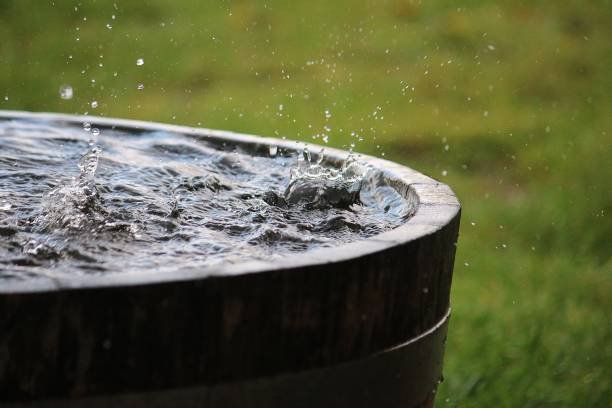On this page, we discuss why distilled water does not conduct electricity whereas rainwater does.
Water is often regarded as a simple compound with the formula H2O, but its interactions with electricity reveal its complex nature and showcase the intricate relationship between science and nature. Understanding why some types of water conduct electricity while others don’t requires diving into the worlds of chemistry, physics, and environmental science. The theories of ionic conductivity and water purity become crucial to grasping these phenomena. These theories posit that the capacity of a water sample to conduct electricity depends on its ion content, which can vary depending on several factors like purification methods, natural processes, and contamination.
This article aims to unravel the mystery behind why distilled water does not conduct electricity, whereas rainwater does. We will explore this topic through five key reasons: the distillation process that results in ion-free water, the intrinsic absence of ions in distilled water, rainwater’s journey through the atmosphere, the natural acidification of rainwater, and the risk of ion contamination in distilled water. Each reason is backed by real-world examples that illustrate the scientific principles in action. So buckle up as we take a detailed journey through the fascinating world of water and electrical conductivity.
Article Highlights
- Exploring the role of the distillation process in removing ions from water.
- Understanding the impact of an absence of ions in distilled water on its conductivity.
- Investigating how rainwater’s journey through the atmosphere affects its ionic composition.
- Discussing the natural acidification of rainwater and its impact on conductivity.
- Examining the risks of ion contamination in distilled water and how it can change its properties.
Why Does Distilled Water Not Conduct Electricity Whereas Rainwater Does?
Distilled water does not conduct electricity because it is purified through a distillation process that removes all ions and impurities, leaving it devoid of charged particles that could facilitate electrical conductivity. On the other hand, rainwater does conduct electricity because as it falls through the atmosphere, it picks up various ions and impurities like dust, pollutants, and natural acids. These ions serve as a pathway for electrical charges to move, making rainwater a conductor of electricity.
Reason 1: The Distillation Process
The distillation process is pivotal in creating a water medium that lacks ions. Water is boiled and turned into vapor, leaving behind any soluble substances, including ions and minerals. This vapor is then cooled down in a different chamber and condensed back into liquid form. This water is now “distilled,” devoid of impurities that could facilitate electrical conductivity.
Examples:
- Laboratories: In lab settings, distilled water is used as a solvent for various reactions because of its purity, ensuring that no ionic interference takes place.
- Cosmetics: In the cosmetics industry, distilled water is often used in formulations to maintain product integrity.
- Automotive Cooling Systems: Distilled water is preferred in cooling systems of cars to prevent ion-induced corrosion.
Reason 2: Absence of Ions in Distilled Water
No ions in the water mean no pathways for electrical charge to flow through. This lack of ions turns distilled water into an insulator, making it incapable of conducting electricity. Even a single ion per trillion molecules can change this characteristic, but completely ion-free distilled water is a perfect insulator.
Examples:
- Electrical Experiments: For electrical conductivity tests, scientists use distilled water as a control substance.
- Fish Tanks: Aquarium enthusiasts prefer distilled water because its lack of ions helps maintain a controlled environment.
- Food Industry: In food processing, the use of distilled water ensures that unwanted ions don’t interfere with the quality of the product.
Reason 3: Rainwater’s Journey Through the Atmosphere
Rainwater is a nature-made conductor. It travels through the atmosphere, absorbing various forms of impurities like dust, pollen, and even pollutants like sulfur dioxide from industrial emissions. All these impurities contribute ions to the rainwater, enabling it to conduct electricity.
Examples:
- Acid Rain: Pollutants like sulfur dioxide can cause rainwater to become acidic, enhancing its conductivity.
- Water Quality Monitoring: Studies often analyze the ionic content of rainwater to understand environmental pollution levels.
- Agriculture: Farmers are concerned with the quality of rainwater as high levels of impurities can affect soil and crop quality.
Reason 4: Natural Acidification of Rainwater
Rainwater’s capacity to dissolve carbon dioxide from the atmosphere results in the natural formation of carbonic acid. This acid then dissociates into hydrogen and bicarbonate ions, which contribute to the water’s electrical conductivity.
Examples:
- Weathering of Rocks: Acidified rainwater can accelerate the weathering process of rocks.
- River Ecosystems: The natural acidification can impact the aquatic life and water quality in rivers.
- Natural Water Sources: Springs and underground reservoirs can be affected by the acidification of rainwater, altering their ionic balance.
Reason 5: Risk of Contamination in Distilled Water
Distilled water’s lack of ions makes it susceptible to becoming conductive upon contamination. A minor amount of contamination can significantly change its properties from an insulator to a conductor.
Examples:
- Storage: Distilled water can absorb ions from the containers it is stored in, altering its insulating properties.
- Medical Uses: In medical applications, the purity of distilled water must be maintained to ensure its non-conductive nature.
- Public Supply: Even when distilled water is used in public water systems, strict monitoring is necessary to avoid ion contamination.
Conclusion
In essence, the electrical conductivity of distilled water and rainwater is governed by a series of intricate factors like the distillation process, ion content, atmospheric journey, natural acidification, and contamination risk. Each of these elements provides a lens through which we can better understand the myriad ways water interacts with electrical energy. This understanding has broad implications, ranging from scientific research to water quality assessment and various industrial applications.

